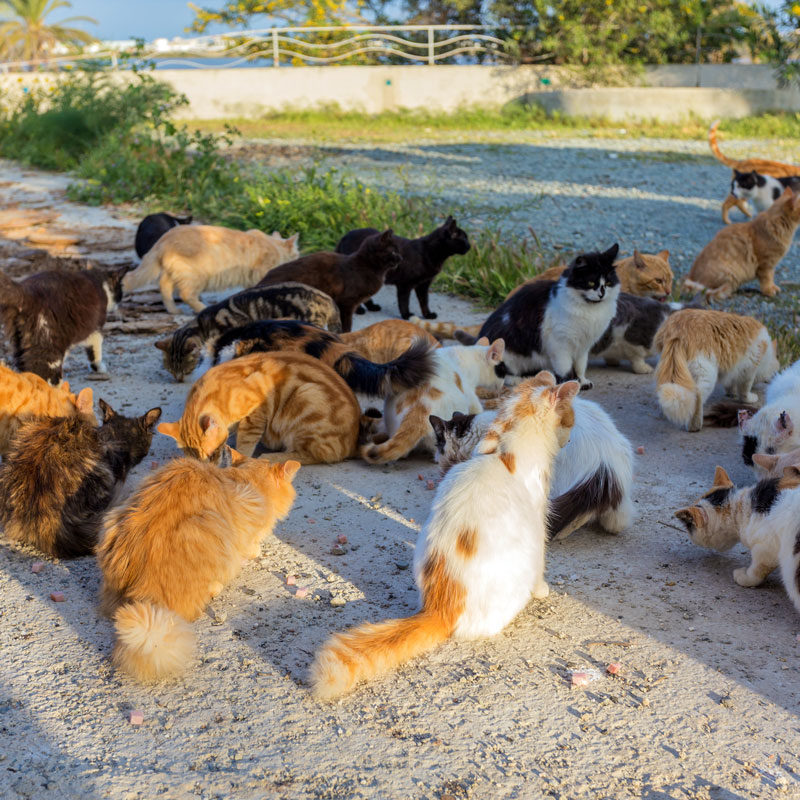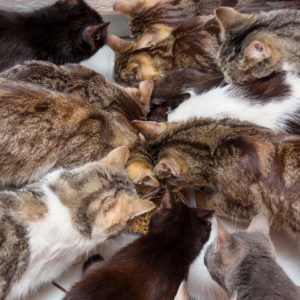
Pack Up Your Cat and Travel with Emily Miethner, Co-founder Travel Cat
August 23, 2022
Emotional Support Animals with Daniel Maigler, LCSW, Mental Health Advisor for Paws for Patrick
August 30, 2022
Contributed by Dawn Benefiel, Executive Director of Indy Neighborhood Cats
When a colony exceeds 20 cats, setting up your project can be a challenge. We know that in order to make a dent in a large unaltered colony, we need over 90% of the cats to be spayed/neutered, vaccinated, ear tipped, and returned to their home outdoors. Our preference is always 100% and people often ask us how we achieve high completion rates with a high level of success. Here are some tips to help you organize and execute your own mass trapping project.
Create a Plan
Creating a plan for mass trapping is not as simple as getting a report of 20 or more cats at a single colony location and popping it on the schedule. We recommend an on-site visit at least 3 weeks prior to your estimated trapping date. Your on-site visit should include time with the caretaker at the colony location. You should schedule a time when the caretaker usually feeds. This allows you to see if the cats feed in what we love to call a “swarm”. The “swarm,” is when all the cats rush out to the food and congregate together. If you do not see a swarm, you will want to encourage the caretaker to begin feeding at ONE time a day. This time should be the time you will want to trap the cats to get them to the Spay/Neuter clinic. Your job is to make sure the caretaker understands that the success of the project hinges on the ability to have as many cats in one place at the same time as possible.
 We often face roadblocks when a caretaker feeds cats as they see them come up seeking food. So be confident and explain the importance of getting the “swarm” to form. If you need to, you can stay in this mode for as long as it takes. We will often ask caretakers to get the cats eating in “swarm mode” and send us photos like the examples in the images below. If you go into a colony of 20 plus cats and only trap and fix 5, you will not see any reduction in breeding cats. Our team will not schedule mass trapping until we have a “swarm” so the entire colony is spayed/neutered at one time. This is the most cost and time-efficient way to start a mass trapping project.
We often face roadblocks when a caretaker feeds cats as they see them come up seeking food. So be confident and explain the importance of getting the “swarm” to form. If you need to, you can stay in this mode for as long as it takes. We will often ask caretakers to get the cats eating in “swarm mode” and send us photos like the examples in the images below. If you go into a colony of 20 plus cats and only trap and fix 5, you will not see any reduction in breeding cats. Our team will not schedule mass trapping until we have a “swarm” so the entire colony is spayed/neutered at one time. This is the most cost and time-efficient way to start a mass trapping project.
Once you have the “swarm” eating at the same time, it is time to schedule your clinic spots. You will need to take into consideration the following items:
- How many cats need to be spayed/neutered
- Are there kittens and/or moms that need foster care or rescue placement? Get them out now. Work with partners to find placement before you start your trapping project for any kittens that can be placed for adoption.
- How many drop traps do you have and how many guillotine box traps do you have access to
- How much space do you have to transport the cats safely
- How many clinic spots you can get sequentially until you get the entire colony spayed/neutered
- Do you have access to holding cats for 24/48 hours to avoid the altered cats mingling with the remaining unaltered cats
Some other setup items you may want to consider:
Canvas the Neighborhood
When there are 20 or more cats in a single colony, there will usually be multiple locations the cats go to find food and shelter. If you only get one of three people in the neighborhood to restrict food, you may end up sabotaging your trapping project. Get door hangers or flyers and place them on doors. You can check the neighborhood for food/water dishes, but we recommend leaving a flyer with your contact info on doors for an entire .2-mile radius. This is the normal range of an outdoor cat’s territory.
Scheduling Your Trapping Day(s)
We always try and use mass trapping for projects when a low-cost/high-volume Spay/Neuter clinic schedules “Spay Days”. If we can, we want to trap every cat on day 1. So, check with all of your clinic resources to see if they schedule days when they focus on community cats.
If your area does not have a clinic doing special spay days, ask clinics if you can get as many spots as possible or set up the project so you trap half of the cats on day 1. Schedule the second batch for the very next day. Most clinics use the national best practices and keep community cats overnight. You can easily go back and trap the remaining cats while your first batch is in surgery. This prevents already altered cats from going into traps you set.
Take an inventory of what you will need for your trapping project.
Here is a quick list we use:
- Drop traps- These traps allow you to catch multiple cats swarming to eat. For a colony of 20, we recommend 3 drop traps. You can usually get 3-4 adults in one drop trap with proper food placement. For the best advice on using a drop trap, check out the free webinar from Community Cats Podcast and Neighborhood Cats!
- Guillotine Traps – You will want traps with a sliding back door.
- Stinky aromatic wet food – Canned tuna in oil, canned mackerel, sardines, Fancy Feast Pate, and Sheba Perfect Portion Pate are all great options.
- Newspaper – We cannot emphasize enough that while trapping, the best moisture-absorbing item you can use is a newspaper. We love puppy pads too but a cat who is under-socialized will be pretty panicked at first. Puppy pads just get shoved around too easily and almost always require you to add new pads after trapping. Newspaper, when folded to fit the trap, is more formed and does not unfold and bunch as easily. We recommend 4 sheets of newspaper folded over. It should be thick enough to absorb plenty of moisture.
- Trap forks – Trap forks are vital to caring for a community cat while they are in a trap. The trap fork allows you to isolate the cat to one side of the trap to change out bedding, food, and water.
- Extending the trap plate – If you want to increase the success of any trapping project, we like to use about 4 inches of cardboard the width of the trap plate. Use painters’ tape to place the cardboard so that it becomes an extension of the plate.
- Trap Covers – Make sure you have covers large enough to cover each drop trap and box trap you have. Then add a few more in case of accidents/soiling.
- Plastic tarps and flat cardboard boxes broken down- If you have 10 plus cats, you may need to place cats on top of one another. To avoid soiling leaks and shock from transport, place flattened cardboard boxes over the first layer of cats. Then put a plastic tarp down and add your second layer. Your car and your nose will thank you! (So will the cats)
- Extra hands – Recruit a couple of people to help. Transferring cats can be challenging. Get some volunteers to help.
- Trap Tags – Have paper tags you can attach to each trap. Include the name of the transporter and their phone number, the cat’s name, colony address, cat breed (dsh, dmh, dlh), color (Orange Tabby, Calico, Black & White, etc.), sex, and age if known. Name of caretaker. This will help make sure each cat goes back to the proper trap and is returned to the correct colony.
- Itemize each cat on a spreadsheet – while you get your trap tags filled out, enter each cat into a spreadsheet. We like to use this to hand to the clinic when we pick up a large number of cats from a single trapping project. The clinic will thank you! Before you leave the clinic, you will want to reconcile each cat’s trap tag, clinic paperwork, and the spreadsheet. If a cat’s description is different from the cat in the trap. Do not leave the clinic until you complete your reconciliation and find the cat’s proper trap and paperwork. While it is not common, mistakes happen. The last thing you want to do is release the wrong cat to unfamiliar territory.
Mass trapping projects are not much different than trapping two cats. The pre-scheduling setup, neighborhood canvassing, and on-site assessments are key to successfully trapping large colonies.
Learn more about trapping and colony care via the workshops and free webinar resources in the Community Cats Podcast Community Cat Care Training & Education library.
About Dawn Benefiel
Dawn has a strong background in Client Services Management and software delivery. She has worked with remote teams locally and in the UK, US and AsiaPac. She has a successful track record of building and maintaining excellent client and partner relationships. After her move to Indianapolis in 2013, she began volunteer work with local animal welfare groups and is now the executive director of Indy Neighborhood Cats. Indy Neighborhood Cats was established in August of 2019 as the only organization based solely in the field of addressing the free roaming cat population. Dawn loves animals, being involved in her community and dedicated to family.




